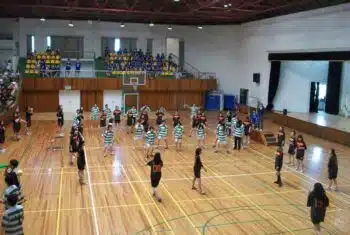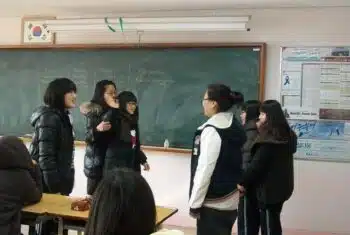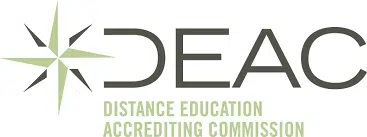From bustling cities like Seoul and Busan to quieter provincial towns, teaching English in South Korea is a unique and rewarding experience that blends cultural immersion with professional growth.
Classrooms across the country are filled with eager students and a deep national commitment to English education. Whether you’re working in a public school through government programs like EPIK or in private after-school academies known as hagwons, you’ll encounter structured curricula, high expectations, and enthusiastic learners.
But what’s it really like teaching English in South Korea?
TTA alumna Sarah to talk to us about her time teaching in South Korea.

I’m Sarah, a South African teacher who spent six incredible years teaching in South Korea.I started out at a foreign language high school in Gunsan, a quiet coastal city in Jeollabuk-do, before moving to Seoul to work as a teacher trainer and English teacher.
I had just finished my Master’s degree and wanted to travel. My brother convinced me that South Korea was the place to go, so go I did.
Read more: How To Work In South Korea As A Foreigner
I come from a teaching family, and I’ve taught everything from pre-school music classes to high school and university English back home.
I thought I knew classrooms pretty well before Korea — but nothing prepared me for the unique, fascinating, and sometimes surprising South Korean classroom culture.
Whether you’re just curious or seriously considering a move, here’s my honest take on what it’s like to step into a Korean classroom as a foreign teacher.
Before you teach in South Korea: What teachers should know about classroom culture
South Korean classroom culture is heavily shaped by Confucian values. That means teachers are regarded with a level of respect that feels old-school — in a good way.
In many classrooms, students stand and bow at the beginning and end of each class. They greet you in chorus with a polite “Annyeong haseyo, seonsaengnim!” (Hello, teacher!).
But that doesn’t mean it’s all formal and stiff.
Kids will still sneak a text under the desk, giggle in the back row, or ask you if BTS is really famous in your country. You’re expected to maintain authority, but also be warm and supportive.
Key differences between Korean and Western classroom culture
The biggest difference? The teacher is the centre of the classroom, and that’s not always negotiable.
In South Africa, for instance, we’re all about facilitating discussion and giving students a voice. In Korea, especially in public schools, it’s more lecture-style and teacher-led. Participation is often limited to choral repetition or structured activities.
Read more: From Teacher-Centred To Learner-Centred: Transforming Your Classroom For Success
Asking “What do you think?” can be met with blank stares — not because students don’t know but because they’ve been trained to get the ‘right’ answer, not express an opinion. If it’s not in the test, it’s not worth learning.
Not knowing the answer and being called on in class is absolutely mortifying for most students. A bowed head and silence is a sign it’s time to shift attention elsewhere in the class.
Group harmony trumps individualism — which can be frustrating if you’re trying to spark a lively debate! Know-it-all students are a disruption to that harmony, so calling on students is challenging. Similarly, while critical thinking isn’t discouraged, it’s not heavily emphasised in daily classes. So, be prepared to scaffold it gradually.
Understanding student behaviour and classroom expectations in South Korea
Students generally call you Seonsaengnim, or your first name plus ‘teacher’ or nim at the end, and they speak with a tone of genuine formality — at least in class. Outside, they might giggle and avoid eye contact, especially if you’re the only foreigner at school.
Students rarely interrupt, and they almost never challenge the teacher. If anything, they may be too quiet, especially at first. When I arrived, I mistook this for a lack of interest — turns out, they were just being polite.
This doesn’t mean that they won’t tell you when they’re offended by a certain behaviour. This directness and break with formality can come as quite a shock when it first happens, but the intention is to restore group harmony as quickly as possible.
In general, foreign teachers tend to have informal and friendly relationships with their students.
It’s not uncommon to go out for lunch with a group of students, have them over to your home, or have them on your social media and chats — a big no-no back home!
How students show respect for teachers in Korea
Here’s what stood out for me:
- Bowing: It’s automatic. Every class. Every meeting. The deeper the bow, the greater the level of respect shown.
- Two-handed gestures: Whether giving you a paper, a gift, or coffee, students (and even teachers) will often use two hands as a sign of politeness. The non-dominant hands rests on the inside of the elbow of the outstretched hand.
- Verbal respect: They use honorific forms in Korean, and many try to use polite English.
- Bowed heads and eyes down: When reprimanding a student, don’t expect them to maintain eye contact. It’s polite to bow your head and look down when you’re in the wrong.
I even received handwritten apology notes for tiny infractions like eating a sweet in class!
The teacher-student dynamic in Korean classrooms
At first, I felt more like an actor than a teacher — standing in front of a silent room trying to get a reaction. But, over time, I learned that relationships take time here.
Once students trust you, the dynamic softens. You become part-teacher, part-mentor, and occasionally part-entertainer. However, students will ‘judge’ you, at least initially, based on their experience with the previous foreign teacher: A bad experience will make them more hesitant to connect with you, while a positive one will result in a higher level of informality and friendliness from the start.
In a public school, your role will probably feel more like a guest specialist — you’re there to make English fun. You’ll often co-teach with a Korean teacher who handles discipline and instructions in Korean.
In hagwons (private academies), you may have more control over content but higher pressure from parents and the hagwon’s owner or director because a ‘good’ teacher is a well-liked teacher who makes every lesson fun.
That can be tricky to do in every lesson; plus, hagwon lessons start immediately after school and can run until 10 or 11 PM. In short, students are exhausted by the time they get to their English class.
Daily routines and classroom rituals in Korean schools
Sleeping students
Students spend a lot of time in class! From 7 AM to 11 PM in high schools, with hagwon lessons after school — for languages, maths, and music in particular. Seeing students sleeping during a lesson is a major adjustment. Back home, it’s rude; in Korea, it’s something to address gently. I used to take photos and award ‘Sleepers of the Week’ certificates to keep it light-hearted.
Class monitors
Most classes have class monitors who help to manage order, call for silence, or assist the teacher. They’re often more out-going students, or students who have spent a year or more in an English-speaking country.
Student cleaners
Cleaning time is also a routine I had to adjust to. Students clean the classroom and surrounding areas daily — even the toilets. There’s a set time for cleaning at the end of the school day, and teachers are expected to help where needed.
Morning exercise
Some schools also have morning exercises, where everyone gathers in the school gym and follows the 20-minute workout led by the PE teacher. Sports days are fun: there’s some good-hearted teacher-student competition.
Snack gifting
Snack gifting is popular. On Teachers’ Day (5 May) and Pepero Day (11 November) in particular, expect small snacks and notes from students expressing their appreciation.
There are Parent Committees who have to look after the health and well-being of the teachers. It’s common to return from a class and find a rice cake and a health drink on your desk, especially in winter.
The impact of academic pressure on South Korean students
Let’s get serious for a moment: the academic pressure is like nothing I’ve seen before, especially for high schoolers.
They’re in the classroom for up to 16 hours a day, then they go back to the dorms and study for 3-4 more hours. Even elementary and middle school students have more pressure on them than their Western counterparts. These kids eat, live, and breathe education between school and hagwon classes — sometimes 7 days a week!
Class sizes in Korean classrooms
Public schools average 25 to 35 students in a class, regardless of the grade. Hagwon classes tend to be small, with four to 12 students on average. My school had very small classes for English as it focused on languages.
Large classes are normal in middle school, so managing group work or speaking activities takes planning. Group games, team points, and assigning roles helps keep energy up without chaos.
How parents influence education in Korea
The weirdest thing for me was having parents sit in on classes in ‘open classes’. I couldn’t use games in those lessons because class was expected to be serious and formal. Parents can ask to see your lesson plans, sit in on classes, ask questions in class — even if they don’t understand a word of the lesson — and give opinions on what should be done instead.
In hagwons, if a student isn’t improving, you’ll hear about it — sometimes via the director or head teacher. In public schools, parent contact is more formal and usually handled by Korean staff.
Either way, high expectations and pressure to perform filter down from the home.
Teacher dress code in Korea
As a woman, don’t show your bare shoulders or even a hint of cleavage. The biggest shock is that women tend to wear high-neck tops, but micro minis or short shorts are okay. A cap sleeve is the shortest you can get away with while at school.
For guys, button-down shirts and smartish trousers are the norm. You’ll need a pair of ‘slippers’ (think slip-on sandals) and socks for school.
Koreans generally dress well, and neatness matters. Safe bet? Dress one level up from what you think you need until you get a sense of your school’s dress code. Some schools and hagwons are business-attire formal, but many just want neat and presentable. Jeans and hoodies were common at my school.
Difficulties for South Korean students learning
Students are reluctant to make mistakes, so they prefer to stay silent if it’s not perfect. It goes back to learning the ‘right’ answer.
In general, articles (the, a/an) get dropped as they don’t exist in Korean. Similarly, /r/ is substituted with /l/, /v/ is substituted with /b/, and /f/ is substituted with /p/, so a lot of practice is needed on these sounds!
Practical tips for adapting to Korean classrooms
Here are my biggest takeaways:
- Be patient. Silence doesn’t mean you’re bombing. Give students time.
- Use routines. Start each class the same way — greetings, quick warm-ups — it builds confidence.
- Make speaking safe. Try think–pair–share before open-class questions.
- Inject humour and pop culture. K-dramas, K-pop, memes — use them!
- Get to know your co-teacher. They’re your bridge — and they’ll save your life more than once.
It’s normal to feel nervous before your first class. But, by week two, you’ll have your groove (and probably a desk full of mystery snacks from students!). Prepare for class, but also prepare to go with the flow and just have fun.
Author Bio
Teacher in the Field represents our TEFL Academy global community sharing their real-world experiences from classrooms and institutions across the world. From diving into TEFL to chomping down on chow mein in China, to navigating your first-day nerves in Spain, our collective voice brings authentic stories, insights, and practical advice right from those living the adventure.
Read
Teacher in the Field's story →
 United States
US
United States
US
















